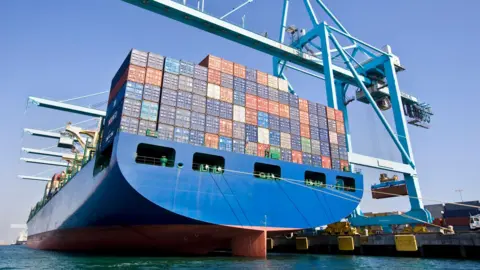The United States and China have recently negotiated a significant truce aimed at reducing import duties on goods exchanged between the two nations. This agreement represents a potentially momentous decrease in hostilities within the ongoing trade war between these leading global economies, which has previously caused widespread disruptions not only between the two but also affecting other countries, including the United Kingdom. In the context of international trade, this deal could have major implications moving forward, raising questions about the future of U.S.-China relations and the impact on global economic stability.
The announcement of this tariff agreement reveals a mutual decision by both the U.S. and China to roll back some of the punitive tariffs initially set in motion by former President Donald Trump earlier this year. Specifically, the plan entails both countries scrapping certain tariffs outright while others will be suspended for a period of 90 days starting from May 14. Under the arrangement, U.S. tariffs on imports from China are expected to be significantly reduced from an existing 145% down to 30%. Similarly, China will reduce its tariffs on selected U.S. goods from 125% to 10%. Moreover, China has also terminated non-tariff trade barriers, like the prohibition on essential mineral exports to the U.S., which were enacted in response to prior U.S. tariff hikes.
While this groundbreaking agreement marks progress, it is equally crucial to underscore that not all pressures have been alleviated on the Chinese side. The U.S. tariffs still reflect a 20% surcharge aimed at compelling Beijing to tackle the illicit trade of fentanyl, an opioid that has become a significant public health crisis in the U.S. The discussions that preceded the announcement occurred in Switzerland, suggesting a renewed willingness for negotiation on both sides, especially after the series of escalating tariffs that have defined recent trade interactions.
Looking ahead, the situation remains fluid, and predicting the precise trajectory of this ongoing trade conflict proves challenging. Although there’s a consensus that this agreement provides a framework for improving relations between the two superpowers, it is also clear that future dynamics will depend heavily on actions taken in the coming months. If the tariffs currently set to be suspended are reinstated after three months, U.S. tariffs could escalate to 54% while Chinese tariffs could rise to 34%. Nevertheless, both sides appear committed to continuing dialogue, as underscored by statements from key officials, including U.S. Treasury Secretary Scott Bessent, who emphasized the intent to avoid economic decoupling.
The trade exchange between the United States and China spans a vast array of goods. In 2024, for instance, soybeans emerged as the top U.S. export to China, primarily for livestock feed, while pharmaceuticals and petroleum also constitute significant exports. Conversely, China exports an array of electronic devices, including smartphones, with Apple’s iPhone being a prime example of a high-demand product. Exceptional trade imbalances persist, with Americans importing approximately $440 billion from China while exporting just $145 billion in return. This disparity has been a focal point of discontent for Trump’s administration, motivating tariff implementations in an attempt to bolster American manufacturing and reduce reliance on foreign goods.
The consensus among political analysts is that both sides will claim victory from this truce, even if interpretations will differ significantly. While U.S. officials posit that the reduced tariffs signify a win for American economic interests, others argue that China finds itself in a psychologically advantageous position after negotiations reset the bargaining table. Commentators have pointed to the nuanced implications this agreement carries in setting tariff boundaries, noting how emerging deals could signal broader shifts in U.S. trade policy, particularly with fluctuating relations across different international partnerships.
In conclusion, while the recent U.S.-China tariff deal offers apparent respite in ongoing trade tensions, the complexities of global economic relations and domestic policies suggest that much is still at stake. The two nations’ willingness to negotiate further, coupled with their respective market dependencies, could shape international trade contours in the months and years ahead, necessitating close observation from global stakeholders.



